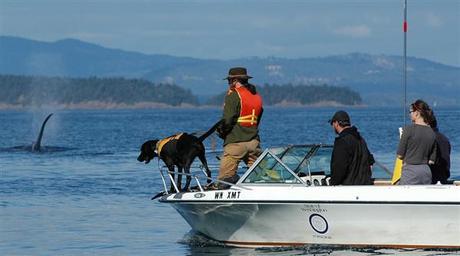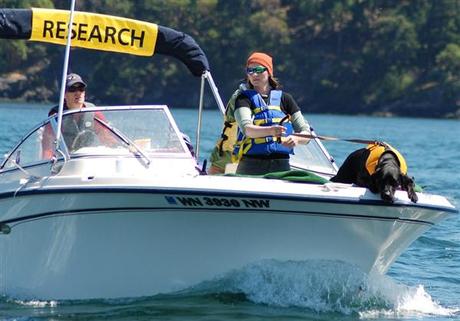 A new study on endangered Pacific Northwest killer whales is getting noticed not just for its findings — less salmon to eat is a much bigger stress factor than whale watching boats — but for who helped out: namely, a black Labrador trained to detect killer whale scat.
A new study on endangered Pacific Northwest killer whales is getting noticed not just for its findings — less salmon to eat is a much bigger stress factor than whale watching boats — but for who helped out: namely, a black Labrador trained to detect killer whale scat.
Cited as “the dog” in the peer-reviewed study, Tucker is credited with allowing researchers to get a better sampling of the resident killer whales in waters off Washington state and Canada’s British Columbia while monitoring from a distance.
“We debated about naming Tucker,” lead researcher Katherine Ayres told msnbc.com, “but decided it was more ‘scientific’ to say ‘the dog’.
“We also wanted this to be a general method that could be applied with other dogs in the future so we didn’t want to make it too specific,” she added. “However, you will see that he has a big — and much deserved — shout out in the acknowledgements.”
Indeed, after thanking numerous humans, the authors concluded with: “Special thanks go to Tucker, the Conservation Canine, for his keen nose and assistance with non-invasive fecal sampling.”
He did that with a nose trained to appreciate the scent of scat from killer whales, also known as orcas, up to a mile away.
Prior to Tucker, researchers had to closely follow Orca pods to find and collect scat samples. But that may lead to shy Orcas staying away from research boats, Ayres said, making for a less representative sampling of the population.
With Tucker,” we were not influenced to follow whales that are naturally charismatic” to humans, such as large males or mothers with calves, said Ayres, a pet-behavior consultant who led the research while a University of Washington doctoral student in biology.

Researcher Katherine Ayres handles Tucker as he zeros in on the scent of killer whale scat. Tucker doesn’t go into the water, he just leans over the bow in the direction the boat should travel.
The scat was used to detect hormones released by “southern resident killer whales,” a population listed as endangered due to low numbers in recent years. Levels of thyroid hormones, which slowly regulate metabolism based on food availability, showed the orcas were best fed when first arriving in the Salish Sea off the coast of Washington and British Columbia.
The researchers also found that fast-acting stress hormones known as glucocorticoids, which are triggered by immediate danger and food stress, did not spike when whale watching boats reached their annual peak around the orcas.
“As Chinook salmon increased, stress levels went down,” said Ayres.
The study did, however, find a cumulative impact from vessels on stress. “Say the only place in town to eat is a noisy/crowded bar,” Ayres said by way of analogy. “If that bar has all the food you like and plenty of it, you might not be that bothered by the noise. However, if you are starving and the buffet only has rice and potatoes, you might start to notice the noisiness more and you might become more stressed by it.”
